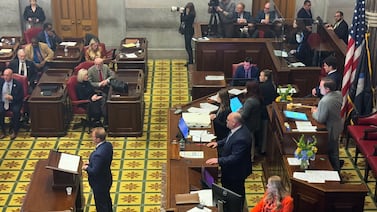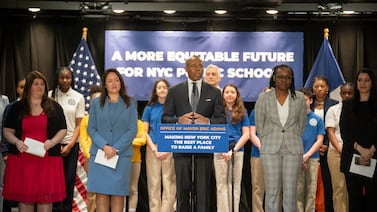Sign up for Chalkbeat’s free weekly newsletter to keep up with how education is changing across the U.S.
HVAC projects to improve indoor air quality. Tutoring programs for struggling students. Tuition support for young people who want to become teachers in their home communities.
These were some of the ways Maryland schools were using what remained of the state’s federal pandemic relief dollars.
Those projects and similar ones in schools around the country are now on hold — and states and school districts are on the hook for hundreds of millions of dollars — after Education Secretary Linda McMahon said the U.S. Department of Education would not pay for any more expenses related to pandemic recovery.
In a letter to state education leaders Friday, McMahon said the department would not honor deadline extensions to spend COVID aid it had approved just a few months ago under the Biden administration.
“Extending deadlines for COVID-related grants, which are in fact taxpayer funds, years after the COVID pandemic ended is not consistent with the Department’s priorities and thus not a worthwhile exercise of its discretion,” the letter states. “The Department’s initial approval of your extension request does not change anything.”
The last opportunity to spend pandemic relief money was 5 p.m. Friday, the same day McMahon sent the letter.
Maryland State Superintendent Carey Wright called the decision “catastrophic.”
“These funds have been spent or committed with every expectation of reimbursement,” she said. “The federal government must keep its word to students, educators, and families.”
The federal government allocated roughly $190 billion to U.S. schools across three separate aid packages to help them respond to the challenges of COVID. The last and largest of these, the American Rescue Plan, provided $123 billion to K-12 schools, with 20% of the money required to go toward academic recovery.
The original deadline for schools to spend that money was January — and most schools met that deadline. But some ran into supply chain problems. And labor shortages slowed down construction projects as well as tutoring programs. In other cases, fewer students than expected enrolled, so the programs cost less than anticipated.
The needs that pandemic relief funds were meant to address haven’t gone away. Results from national and international tests find that student performance remains below pre-pandemic levels. Students continue to miss school at a high rate.
The Biden administration created a process for states to request extensions on their own behalf and on behalf of school districts. An analysis by K-12 Dive late last year found that the U.S. Department of Education had approved at least $1.7 billion in extension requests and expected to approve more.
Schools with extensions would have until March 2026 to spend the last of their COVID relief dollars.
School districts and state education departments went ahead with contracts for construction, tutoring, and more based on those deadline extensions.
In an emailed statement, Madi Biedermann, deputy assistant secretary for communications at the federal Education Department, said those extensions set a bad precedent and allowed money to be spent beyond their intended purpose.
“COVID is over,” she said. “States and school districts can no longer claim they are spending their emergency pandemic funds on ‘COVID relief’ when there are numerous documented examples of misuse.”
States can submit requests for reconsideration for individual projects, and decisions will be made on a case-by-case basis, Biedermann said.
But state education officials said they already explained the purpose of their projects when they requested deadline extensions.
“We went through an extensive process of justifying these expenses during late liquidation, and now we’re being asked to do it again, and also being told we may not receive these funds,” said Joshua Michael, president of the Maryland State Board of Education. “This feels like the opposite of efficiency to me.”
The federal department did not respond to questions about how much money is being withheld or how many states or school districts are affected.
Maryland education officials said the state already had reimbursed school districts $305 million for which they had expected federal reimbursement, and school districts had made commitments for another $113 million, some of which they may have spent.
Michigan education officials said 27 school districts had entered into construction contracts worth some $40 million based on assurances that they had another year to spend the money. State Superintendent Michael Rice said school districts may have to eat into their savings or cut costs elsewhere to honor those contracts.
In New Jersey, Gov. Phil Murphy said 20 school districts could lose out on $85 million.
The Council for Chief State Schools Officers said it is still working to understand the full scope of the issue.
Elleka Yost, director of advocacy and research for the Association of School Business Officials, said school districts still will have to honor their contracts, which could mean cutting other budget areas.
“Federal funding has become increasingly unpredictable for districts, making it very difficult for school business professionals to accurately forecast and plan,” she said.
Before McMahon’s letter, many states already reported delays in reimbursements for which they had already submitted paperwork. Earlier this year, the Department of Education announced it would apply greater scrutiny to requests for reimbursement, requiring states to first spend money and then show that it was for an approved purpose.
Still, states may yet be reimbursed for some of the money that’s currently outstanding.
Marguerite Roza, who has closely tracked pandemic relief spending as director of the Edunomics Lab at Georgetown University’s McCourt School of Public Policy, said many states worked hard to spend all their money before the original deadline, when the need was greatest.
Those that were slower to ramp up spending are now more exposed to the changing political tides in Washington, Roza said. At the same time, the Biden administration encouraged states and school districts to find ways to keep spending the money rather than return it — and districts acted on those incentives.
McMahon’s letter, she said, is making the process “needlessly chaotic.”
Erica Meltzer is Chalkbeat’s national editor based in Colorado. Contact Erica at emeltzer@chalkbeat.org.






